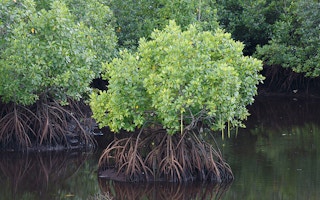The district of Pitas in the Malaysian state of Sabah is situated on the 40-kilometer Bengkoka peninsula on the island of Borneo, stretching east into the South China sea.
This forested, hilly area slopes down to the coast along the Telaga River, through ancient mangrove forest. But since the 1980s, it has been increasingly opened up by government-sanctioned development projects; more recently, in 2013, mangrove clearance has resumed for the commercial farming of shrimp (also referred to as prawns).
This resurgence has brought the company Sunlight Inno Seafood Company Sdn Bhd, which is supported by the government, into conflict with local communities that depend on the mangroves for their livelihoods.
In response to mangrove clearance, six indigenous Orang Asli communities in the district have come together to form the “Group of Six” (G6) collective Pitas action committee. It aims to save around 1,000 acres of the remaining mangroves and get this area legally designated under their Native Customary Rights (NCR).
Farmer and fisherman Mastupang Bin Somoi, 52, from Kampung Sungai Eloi, is founder and Chairman of the G6 collective. In his gardens he grows vegetables, rice and a few rubber and oil palm trees. He shows me a handful of large shellfish he has gathered from the muddy riverbed at the nearby boat landing. He says the villagers in the area depend on a mix of farming, fishing and collecting non-timber forest products from the mangrove forest for their livelihoods.
“
They used to be quite friendly, they were not scared of humans, but now after their habitat’s been destroyed they’ll keep their distance.
Mastupang Bin Somoi, founder and chairman, G6 collective
“They used to be quite friendly, they were not scared of humans, but now after their habitat’s been destroyed they’ll keep their distance,” Somoi says as he watches two proboscis monkeys (Nasalis larvatus) bound through the trees. As the boat he’s on proceeds along a channel through the mangroves, a two-meter (6.5-foot) estuarine crocodile (Crocodylus porosus) slides from the bank into the water.
These mangrove forests are home to a wide diversity of vulnerable species, some of them listed under the Convention on International Trade in Endangered Species of Wild Fauna and Flora (CITES).
“This sign says, ‘no encroachment’,” says Somoi, pointing to a sign tied to a tree. The signs have been placed by the communities to demarcate the perimeter of the mangrove forest claimed under their NCR.
Around 2,300 acres have already been cleared under the project and this is set to expand next into an additional 1,000 acres, pending the outcome of an Environmental Impact Assessment (EIA) started in 2015.
Further along, Somoi points out a burial site he says is sacred to the communities. Soon the dense mangrove forest opens into a clearing of stark devastation with dead mangrove roots bleached silver by the tropical sun and the dark peat earth beneath torn into grooves by heavy equipment.
Most of the forest has already been cleared and the communities are desperate to retain the remainder on which they depend for resources, as well as the other ecosystem services it provides.
The shrimp farms cut out of the mangrove forests are secured with two-meter-high solid metal fences backed with coils of razor wire to keep people out. One plot visited by Mongabay was an area about 400 meters (1,300 feet) across containing artificial ponds in which water was being circulated with turbine pumps; a handful of workers was on-site.
Lanash Thanda, president of the NGO Sabah Environmental Protection Association (SEPA), described how the project was originally initiated by the Sabah Forest Development Authority (SAFODA) as part of the 2010 Malaysian Economic Transformation Programme to bring economic development to the poverty stricken area.
“There is no water connection so people save rainwater from their roofs and when that is gone have to pay for deliveries,” Thanda said. She explained that levels of poverty in Pitas are high compared with most of Sabah.
However, according to Thanda, the project has floundered due to mismanagement and a lack of processing, storage and transportation infrastructure.
“Look at their office – it’s new. That’s the prawn farm company. When I came in November it wasn’t there,” said Thanda, explaining how the project is proceeding despite initial deficiencies.
“The Sunlight company was supposed to open a plant in Pitas to process prawns and provide 3,000 jobs, but nothing is happening,” Thanda told Mongabay.
She said local people are dismayed that foreign workers have been brought in, and that few of the jobs originally promised have materialized. Sunlight Inno Seafood Company Sdn Bhd did not respond to requests for comment.
The boat stops at a large stand of dead mangrove trees. The communities suspect they were poisoned because at the same time the trees died, “all the fish died” in the area, Thanda said.
This area of mangroves was frequently used by local communities, and its destruction galvanized members from the G6 collective into action. In June 2015 they confronted workers clearing the area with heavy equipment.
This story was published with permission from Mongabay. Read the full story.










